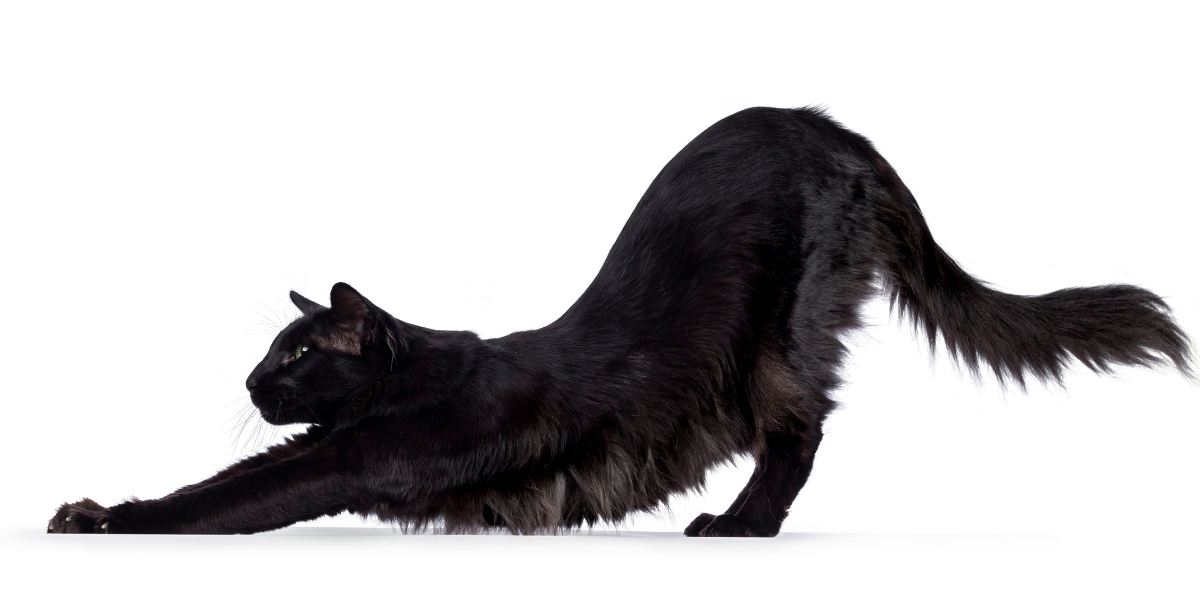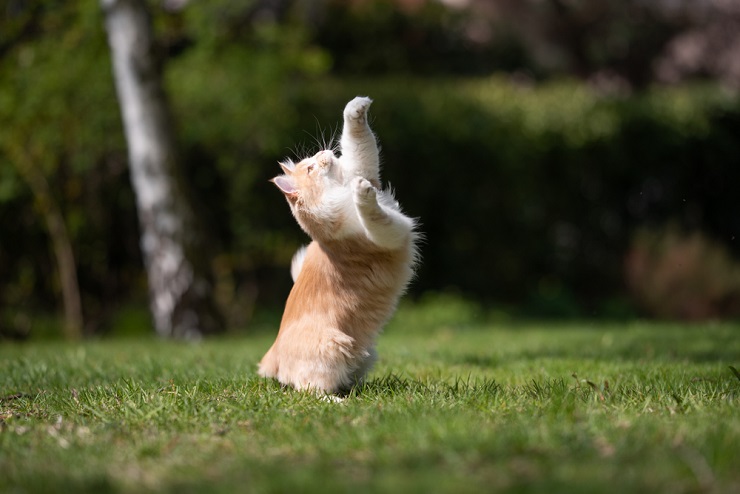
As a devoted cat owner, I often marvel at my cats’ abilities to contort themselves into the oddest positions for grooming, playing, or even sleeping. I also admire their outside acrobatics, leaping up onto our stone wall, jumping and twisting in mid-air to catch a falling leaf, and pouncing on each other in a playful rough and tumble.
Cats have a well-adapted physiology for flexibility and agility. They have cushioned vertebrae that can twist and flex, long tails for balance, and loose shoulder blades for long strides and bursts of speed. Their handily small clavicles allow them to squeeze through tiny gaps, and their inner ear controls their famed ability to land on their feet.
A cat’s body is well adapted to increase their agility and flexibility, allowing for essential survival skills. Thanks to extra elastic vertebrae in the spine, cats can change direction in an instant, twist in mid-air without damaging their spines, and land on their feet. The cat's superior flexibility is useful for hunting, escaping predators, and grooming hard-to-reach places.Key Takeaways
Cats are, quite simply, a marvel of evolution. Read on to find out more about your cat’s flexibility!
Why Do Cats Need To Be Flexible?
We dedicated pet owners provide our modern domestic cats with everything they might possibly need, but their wildcat ancestors had to be more self-sufficient. Often solitary creatures, these felines had to hunt prey, hide from predators, find safe shelter and create satisfactory grooming regimes for adequate self-hygiene.
Cats don’t hunt in packs or chase prey over long distances. Their hunting strategy relies on two things. Firstly, stealthy stalking requires agility and grace, as well as sneaking through small spaces. Secondly, an agile and powerful pounce to catch their unsuspecting prey unawares.
Doing all this alone requires certain flexibility, as well as quick reflexes and a knack for self-preservation. Cat behavior has evolved to rely on their agile bodies, as they also use body posture, tail position, and other visual cues as part of their communication with other cats and with their owners.
What Makes Cats So Flexible?
Let’s talk about interesting cat facts, their anatomy and physiology, and why their bodies are so agile, flexible, and graceful.
1. Flexible Spine

Cats have 53 vertebrae in their spine, with more than 20 of these in the tail.
The first interesting point about cat anatomy is their vertebrae—the bones of the spine. Cats have a whopping 53 vertebrae (that’s a lot more than us humans who have 33), mostly due to having over 20 of these small bones throughout their long tails. These bones in a cat’s spine are very flexibly connected, with elastic cushioning discs between each one.
This elasticity in cats’ vertebrae allows them to rotate their head and trunk around almost 180 degrees, as they have much more flexibility than us. That’s pretty incredible—cats can have their body facing one way while their head and neck are pointing in the opposite direction. This is useful both for hunting and for grooming those hard-to-reach places.
These super flexible spinal connections explain why cats can twist in mid-air without damaging their spines, and change direction in an instant—both essential skills for the type of hunting that cats practice. A cat’s pelvis is also more loosely connected to the spine than other mammals, for added flexibility.
2. Adaptations For Speed
This elasticity in the spine also accounts for cats’ phenomenal ability to sprint at high speeds by lengthening their stride as they run. They alternately extend and flex their body along the spine, which increases their running stride as the body stretches to its full length.
At top speed, each stride length is up to three times their body length, allowing for sprinting speeds of around 30 miles per hour.
Dogs, horses, and humans all have a nuchal ligament. Ligaments are thick, tough pieces of tissue that provide support. The nuchal ligament supports the head on the neck and is useful for species that run fast and far, either to escape from or to catch prey.
Cats don’t have a nuchal ligament, which means their head is more agile, but they can only sustain short periods of sprinting activity, unlike dogs, which can sustain lower speeds for a longer time.
Cats have sharp, retractable claws, which give them additional grip on various types of terrain, allowing agility whatever their location. These claws act like runner’s spikes.
3. Shoulder Blades

The way the feline shoulder blade is attached to the body allows for even more flexibility.
Cats differ from dogs and humans in that the feline shoulder blade is attached to the body wall via muscle only, not bone. This leads to great powers of extension, furthering that long stride of the front limbs needed for sudden bursts of speed when chasing prey. It also allows for added flexibility when performing functions such as grooming.
4. Collar Bone
Humans have long collar bones, anchored firmly in place via bony attachments. Cats, conversely, have very small clavicles, with much freer movement. This explains why cats can squeeze through very tiny spaces—they are limited only by the size of their head, not their shoulders.
The tiny size of these collar bones is also necessary for cats to attain the classic pounce position when about to catch their prey.
5. Tails
The long tail of a cat can be a useful indication of their mood—from high and jaunty for a cheerful greeting to a swishing frenzy if angry, cats often use their tail position as a form of communication. However, tails also provide a useful function in terms of balance as cats climb and jump.
6. Inner Ear
Cats have an excellent sense of balance, with a highly developed inner ear system. They are the proud possessors of a righting reflex, which is the ability for them to always land on their feet.
Cats love to be up high, both for safety from large predators and as a vantage point and therefore need an optimal sense of balance and natural agility.
7. Four Legs And A Compact Body

A low body volume to weight ratio means cats fall more slowly from heights as they can spread themselves out.
Cats, obviously, have four legs, which allows for weight distribution when they jump down and land so that their landing is light and not high impact. Often landing on their front legs, these instinctively buckle, to absorb impact.
They also have a low body volume to weight ratio, meaning that they fall more slowly from heights as they can spread themselves out, almost acting as their own parachute. This is partly why cats have a reputation for having multiple “lives,” as there have been many recorded instances of cats surviving falls from tall buildings.
Also Read: 5 Simple Tips To Keep Cats Off Counters
A cat’s body is full of clever adaptations to increase their agility and flexibility, allowing for a self-sufficient lifestyle. Their skeletal structure is very mobile, with cat’s shoulder blades attached only with muscle, their vertebrae cushioned and their collar bones tiny and loose.
Their body can produce extra-long strides to increase hunting speed, land gracefully with their compact bodies and well-developed sense of balance, and squeeze through tight spaces when necessary.
Also Read: 5 Easy Tricks to Teach Your Cat According to a Cat Behaviorist
Frequently Asked Questions
Why are cats more flexible than humans?
Cats have cushioned spines with lots of vertebrae, small collar bones, and shoulder blades that are attached only by muscle rather than bone. These adaptations all help to make cats agile and flexible.
Why are cats so much more flexible than dogs?
Cats have long spines, with extra cushioning between the vertebrae to allow rotation and flexibility. They also have shoulder blades only attached by muscle, rather than bone in dogs, to allow long strides. Their small clavicles allow them to squeeze into tight spaces.
Why are cat tails so flexible?
Cats have long tails, consisting of 22 to 23 vertebrae. These vertebral bones have fairly loose attachments and are cushioned to allow greater flexibility and rotation.
Why are cats so soft?
Cats have a downy undercoat as well as their outer fur, which makes them super fluffy and soft. They also have very flexible, elastic spines, which means they can act "liquidy," fitting into small spaces in odd positions!







